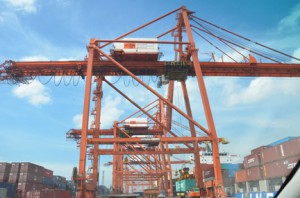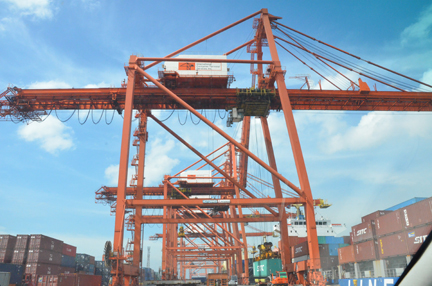 CONTAINERIZED and non-containerized cargo throughput at the country’s seaports grew a modest 2.82% to 41.42 metric tons (mmt) in the first quarter of the year from 40.28 mmt in the same period last year, data from the Philippine Ports Authority showed.
CONTAINERIZED and non-containerized cargo throughput at the country’s seaports grew a modest 2.82% to 41.42 metric tons (mmt) in the first quarter of the year from 40.28 mmt in the same period last year, data from the Philippine Ports Authority showed.
Container volume rose 2.23% to 1.27 million twenty-foot equivalent units (TEUs) from 1.24 million TEUs.
Domestic cargo volume declined 2.50% to 18.29 mmt from 18.76 mmt in the same period last year while foreign cargo throughput jumped 7.47% to 23.13 mmt from 21.52 mmt. Of the total foreign volume, imports accounted for 13.99 mmt while exports reached 9.14 mmt.
Domestic container throughput from January to March inched up 0.62% to 496,329 TEUs from 493,258 TEUs while foreign throughput rose 3.29% to 776,452 TEUs from 751,730 TEUs.
Of the total foreign volume, imports accounted for 401,184 TEUs from the previous 374,840 TEUs while exports declined to 375,268 TEUs from last year’s 376,890 TEUs.
For March alone, total cargo volume registered 14.99 mmt, with foreign volume representing 8.33 mmt and domestic, 6.66 mmt. Of the foreign volume, imports reached 4.6 mmt and exports 3.73 mmt.
Container throughput for the same month amounted to 422,279 TEUs. Foreign throughput hit 247,347 TEUs, with 126,108 TEUs accounted for by imports and 121,239 TEUs, exports.
Domestic throughput reached 174,932 TEUs in March.
Among 12 port management offices (PMOs) that saw acceleration in the first quarter, the highest growth rates were recorded by the ports of Ormoc and San Fernando at 64.59% and 51.56%, respectively, with the former due to increased import and export shipments of commodities such as grains, cement, fertilizer and copra at private ports, and the latter to higher export volumes of sand and mineral ores.
Among all 24 PMOs, Batangas led in terms of volume, recording 5.38 mmt or 12.98% of the total nationwide throughput following encouraging performance of private ports, which handled 91% or 4.89 mmt of the aggregate PMO Batangas volume.
North Harbor came in second with 4.58 mmt. Third and fourth were Limay, Bataan, which registered 3.93 mmt, and San Fernando, La Union, with 2.87 mmt, bolstered by strong operations in both PMOs’ private ports.
Meanwhile, the South Harbor, Tacloban and Iloilo PMOs posted a decline in cargo throughput as a result of unfavorable developments.
Among the baseports, Manila International Container Terminal remained the top performer, handling 11.41% or 4.73 mmt of the total cargo throughput nationwide. MICT’s volume was slightly less than what was handled by the entire Batangas port network.
Second was the North Harbor with 7.1% or 3.26 mmt. Other baseports which processed between 500,000 metric tons and 2 mmt were South Harbor, Davao, Cagayan de Oro, General Santos and Iloilo.
North Harbor port ranked first in domestic containerized volume with 218,731 TEUs.
In the foreign containerized cargo category, MICT handled the largest volume with 426,444 TEUs, followed by South Harbor with 211,978 TEUs and Davao with 101,330 TEUs.
Ports nationwide reported a 2.23% decline in first-quarter shipcalls to 84,663 from 86,598 last year, which PPA said “could have been the result of consolidation moves by carriers where bigger but fewer vessels are being deployed for economies of scale, particularly for foreign vessels.”
In March alone, there were 32,156 shipcalls.
Passenger volume rose 8.3% in the first quarter to 12.43 million from 11.48 million, although the number still reflected the impact of competition from low-cost air carriers.
Photo courtesy of International Container Terminal Services, Inc





